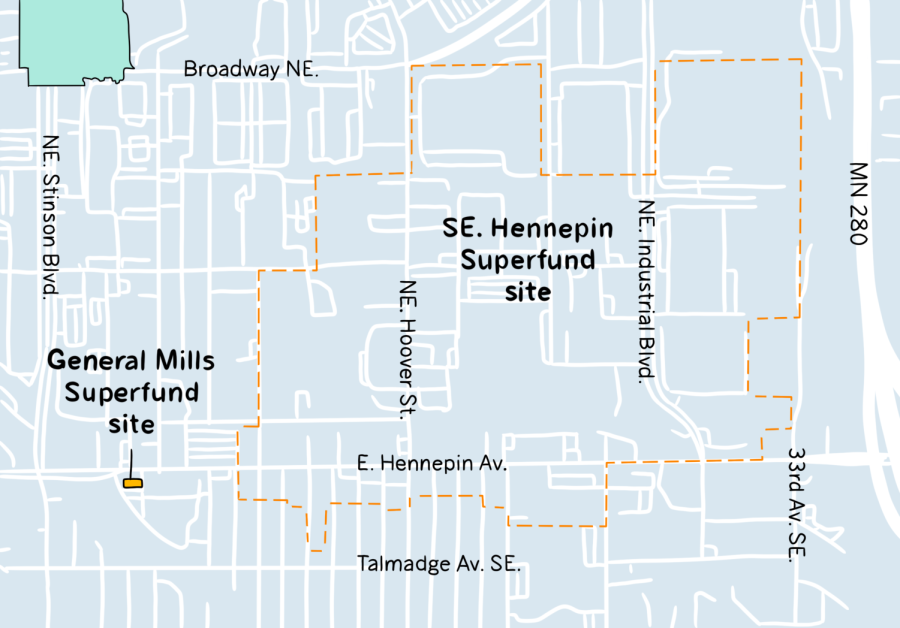The process to clean up an industrial Superfund site in Southeast Como will begin in late summer after being in the neighborhood for more than 40 years.
Last March, the decades-old Southeast Hennepin site was recognized by the Environmental Protection Agency (EPA) as a Superfund site and was added to the National Priorities List for cleanup.
A Superfund site is an area that has been polluted by hazardous materials and has been selected by the federal government for cleanup, according to the EPA.
Alongside the Minnesota Pollution Control Agency (MPCA), the EPA has taken the first steps on notifying local residents about the cleanup process as community concern over exposure to hazardous materials grows.
History of Como Superfund sites
The Southeast Hennepin site, which spans between Northeast Broadway and East Hennepin Avenue, has trichloroethylene-polluted groundwater. The site has contained a number of operations, including a gravel pit, outdoor motor manufacturing and metal finishing.
Although the site is in a predominantly industrial location, it borders a residential area.
Trichloroethylene (TCE) is commonly used by industrial corporations to degrease large machines. Exposure to the chemical can impact immune and reproductive systems, the liver, kidneys and central nervous system, according to the MPCA. It can also increase the risk of liver cancer.
Those who live and sleep in basements often receive increased exposure to TCE and its risks because it accumulates below ground-level.
A second site in Southeast Como, known as the General Mills/Henkel Corp. Superfund site, located at 2110 E. Hennepin Ave., received EPA recognition in 1984 after creating a half-mile TCE plume underground from its use of the chemical during research.
Its groundwater was tested and pumped out, but TCE vapor was found years later in 2013 at the Southeast Hennepin site, which received state Superfund recognition in 2016. Now, the state and federal government are working together to assess the risks and conduct a cleanup of the site.
Clean up process
After holding numerous community listening sessions, the EPA and MPCA will begin the cleanup process in late summer, which will take five to six years to complete, according to Andy Eddy, MPCA project manager for integrated remediation.
The initial steps will include surveying and filling in data gaps to determine the extent of the vapor plume and map out what clean up will look like, according to Eddy. The investigation is expected to take 12 to 18 months.
“We don’t believe there are any imminent public health risks going on with either of these sites,” Eddy said. “It will take time for a long term investigation because we want to do it well in a way that serves the community the best that it can.”
Currently, there is only research on close up exposure to TCE in factories or manufacturing plants and little is known about the impacts of TCE ground vapor on health. Southeast Como residents are not exposed to TCE-contaminated water because they are connected to municipal water, according to Eddy.
Community awareness
Many community members have learned about the Superfund sites through the listening sessions or from living in the neighborhood for many years.
Southeast Como Improvement Association (SECIA) environmental committee member Peggy Booth has lived in the neighborhood for more than 40 years. She has known about the Superfund sites since they received state and federal recognition and said she is concerned about their health implications.
“We shouldn’t have these chemicals underlying where we live and work,” Booth said. “This is something where there needs to be a collective community response that holds the people who caused it responsible for actually cleaning it up.”
Booth said the MPCA and EPA are trying hard to engage with neighborhood residents, but they have difficulties reaching many because a large majority of residents are renters.
Students and renters in the area can learn more about the clean up process through SECIA and the EPA.
Minneapolis Ward 1 City Council Member Elliott Payne said it is important that students are informed about the Superfund site and the cleanup process so they know the potential health risks they are exposed to.
“These are decades long issues, and if you’re just moving into the neighborhood for a school year, or even as short as a semester, it’s sometimes hard to really know that this is going on,” Payne said.
Payne noted that the Southeast Como Superfund sites share similarities with the Roof Depot site in the East Phillips neighborhood, which has been a topic of council discussion over the last two years.
The Roof Depot site is a plot of land in the East Phillips neighborhood that contains high levels of arsenic from manufacturing that has spread to the surrounding community. It was formally cleaned up by the EPA in 2011.
“It’s important to continue to highlight the legacy of the polluting industry,” Payne said. “Oftentimes, those industrial zones were purposely put in or adjacent to communities that were marginalized.”














